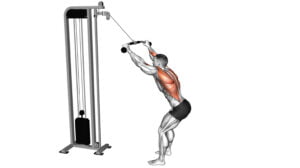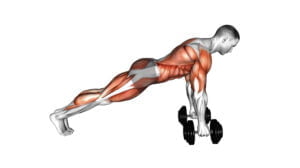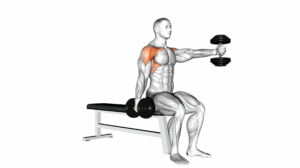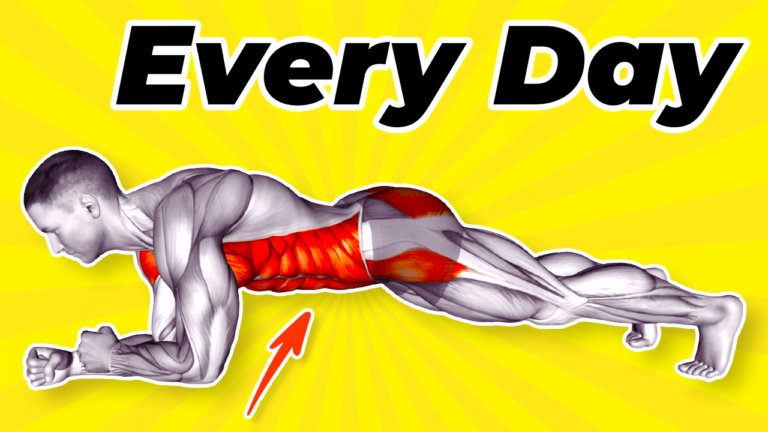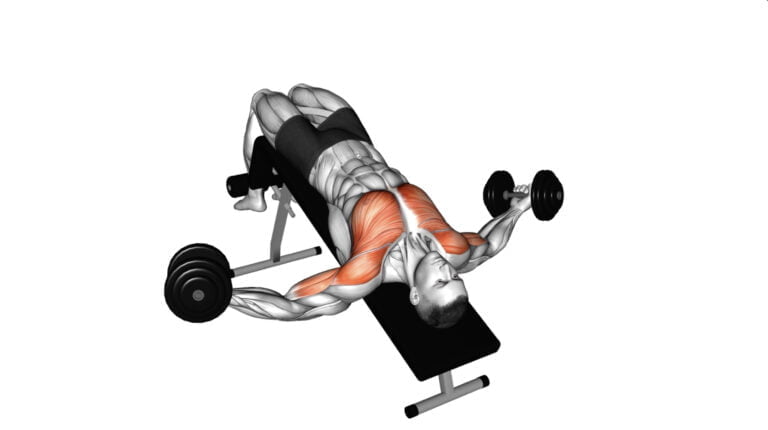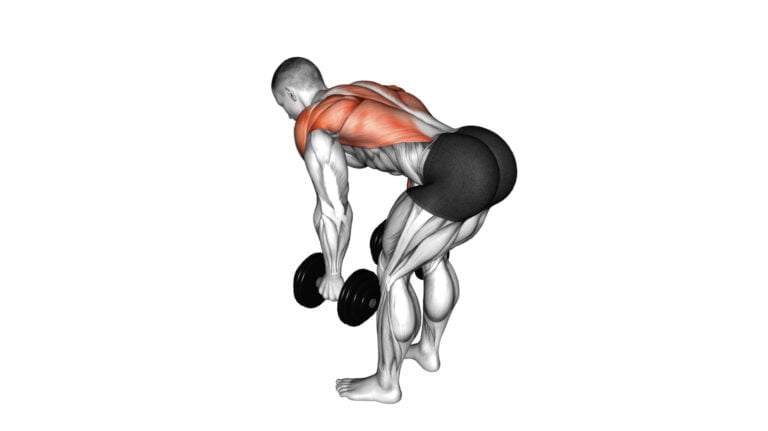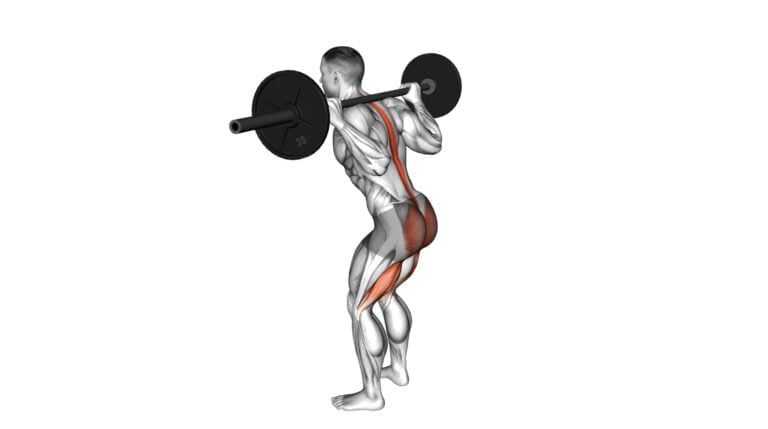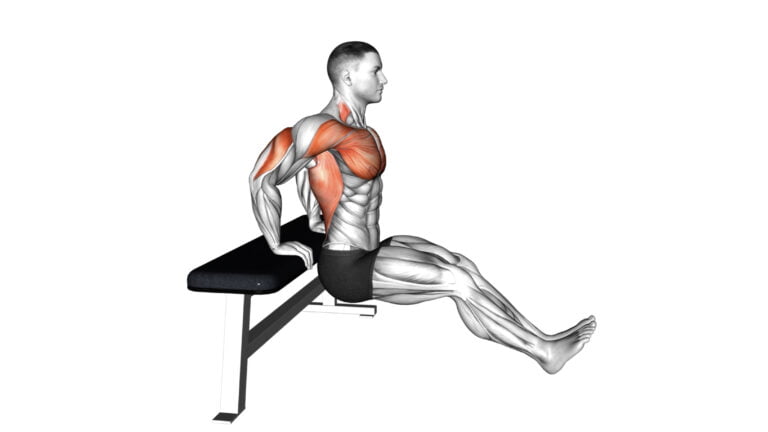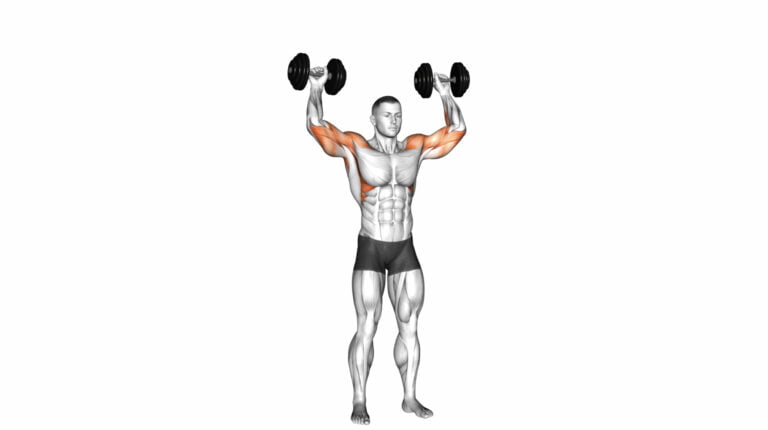7 Dumbbell Exercises For Traps: Build Stronger And Fuller Upper Back Muscles
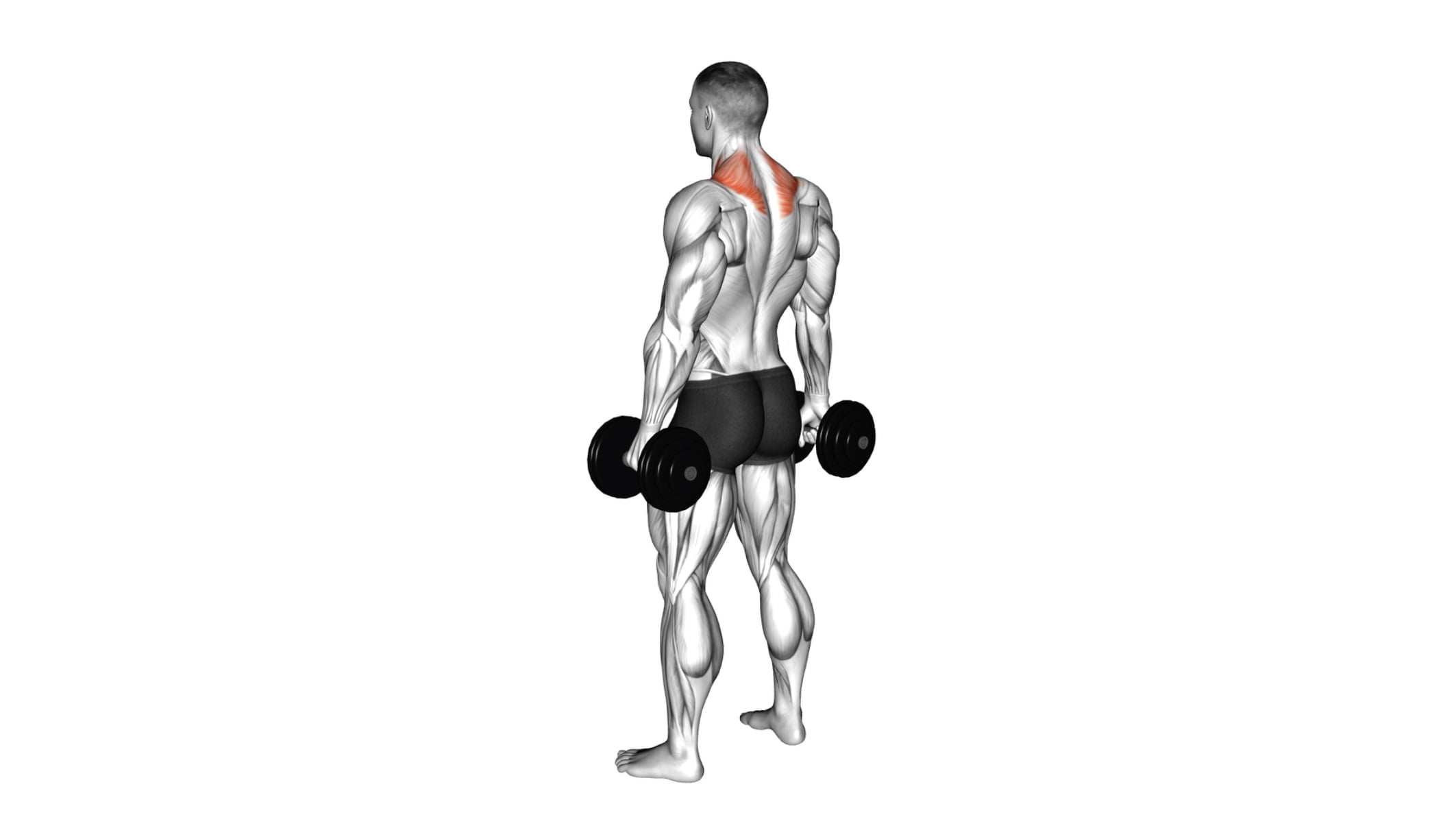
If you’re struggling to give your upper back the attention it deserves, you’re not alone. Often overlooked in favor of more prominent muscles, the traps are a key player in completing that powerful V-shaped torso and ensuring functional shoulder health.
With over a decade of experience sculpting physiques as a certified personal trainer, I’ve witnessed firsthand how targeted exercises can transform an understated back into a bastion of strength.
Dumbbell exercises for traps offer a versatile path to build muscle where it counts; they can significantly enhance your posture and overall upper body aesthetic when performed correctly.

This article will unveil my top seven dumbbell moves designed to fortify your trapezius muscles and unlock new dimensions of muscular power. Get ready to elevate your workouts with these game-changing techniques!
Key Takeaways
- Dumbbell exercises for traps enhance posture, shoulder health, and upper body strength. They are pivotal in maintaining functional shoulder stability and can significantly impact your athletic performance.
- To target the trapezius muscles effectively, incorporate a variety of dumbbell exercises such as incline shrugs, single-arm shrugs, jump shrugs, seated Gittleson shrugs, and decline shrugs into your workout routine.
- Focus on proper form and technique when performing trap exercises to avoid common mistakes like rounded shoulders or using excessive momentum. This ensures maximum muscle engagement and reduces the risk of injury.
- Varying rep ranges and incorporating tempo changes or isometric holds can challenge your traps further. Pair these workouts with complementary back exercises for balanced muscle development.
- Prioritize rest days between workouts to allow for recovery and muscle growth. Combine this with adequate nutrition to support the repair process post-exercise for optimal results in building stronger traps.
The Importance of Building Strong Traps
The trapezius muscles, commonly known as traps, play a crucial role in shoulder stability and upper back strength. Strong traps contribute to good posture, shoulder health, and overall upper body function.
Engaging in dumbbell exercises for traps can help build stronger and fuller upper back muscles while also improving your overall athletic performance.
Trap anatomy
Your trapezius muscles, or traps for short, form a diamond shape across your upper back, neck, and shoulders. They start at the base of your skull, stretch out to each shoulder blade, and then travel down to the lower spine.
These muscles play a pivotal role in moving, rotating, and stabilizing your shoulder blades (scapulae) as they support the arms’ weight and allow for an array of movements that include shrugging and pulling.
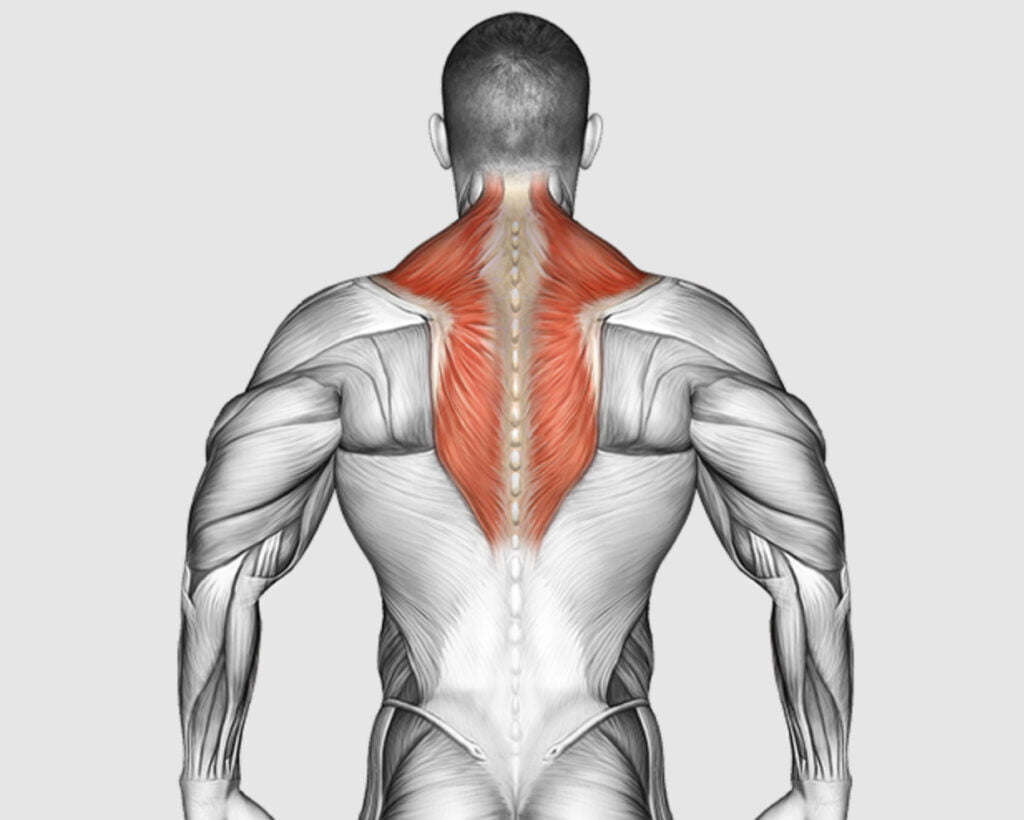
Understanding these muscles is crucial because they’re involved in many exercises beyond simple shoulder shrugs. Traps help maintain proper posture by keeping your spine aligned; they also assist with movements like upright rows and deadlifts which engage various parts of this versatile muscle group.
Next up are benefits strong traps can bring into your life – not just for lifting weights but everyday activities too!
Benefits of strong traps
Strong traps contribute to an impressive upper back and can transform your overall physique. As one of the key muscles in your back, well-developed traps help support good posture by keeping your shoulders aligned.
They also play a critical role in movements that involve lifting and rotating the arms. Whether you’re carrying groceries or executing a perfect clean and press, having strong traps makes these tasks easier and less likely to result in injury.
Developing powerful trapezius muscles not only supports daily activities but also enhances athletic performance across various sports—from powerlifting to bodybuilding, even to throwing a baseball.
Stronger traps mean more strength for shrugs, deadlifts, and rows, which translates into better stability for the shoulders and neck during high-intensity training sessions or heavy weight lifting.
These benefits extend beyond just looking great; they empower movement efficiency, reduce risk of muscle strain around the neck area, and enable proper function of surrounding muscles like lats, rotator cuff components, levator scapulae—and ultimately lead to greater upper body strength.
The 7 Best Dumbbell Exercises for Traps
In this section, we will discuss the 7 best dumbbell exercises for traps to help you build stronger and fuller upper back muscles. These exercises are essential for targeting the trapezius muscle from different angles and maximizing your gains.
So get ready to elevate your trap game with these effective dumbbell exercises!
1. Dumbbell Incline Shrug
The Dumbbell Incline Shrug is a superb exercise for targeting the upper traps and adding serious muscle to your upper back. To perform this move, position yourself face down on an incline bench; make sure your feet are planted firmly on the ground.
Hold a dumbbell in each hand with palms facing towards you, letting them hang directly below your shoulders. By shrugging your shoulders upwards while keeping your arms straight, you’ll create an intense focus on building those trap muscles.
Engage your core and work to maintain a neutral spine throughout the lift to protect your lower back from strain. Keep those elbows locked as you elevate your shoulders towards your ears – avoid using other muscles by keeping it pure and precise.
Allow for a moment of isometric contraction at the top before lowering back down slowly; this maximizes tension on the traps leading to better strength gains and fuller muscle development.
Remember not to rush through reps – controlled movement ensures maximum effectiveness so that every lift counts toward carving out powerful deltoids and a stronger overall upper body frame.
2. Dumbbell Single Arm Shrug
The Dumbbell Single Arm Shrug targets one side of the upper back at a time, helping to correct any strength imbalances between the left and right traps. To perform this exercise, stand with feet shoulder-width apart, holding a dumbbell in one hand with your arm by your side.
Keep your shoulder down and slowly elevate it as far as possible, hold for a second at the top before lowering back down. This movement helps isolate and build strength in each trap individually.
Focus on keeping your shoulders level throughout the movement to maximize effectiveness while avoiding unnecessary strain on the neck or surrounding muscles. Gradually increase weight as you progress to challenge both sides equally and encourage balanced development.
3. Dumbbell Shrug
To perform the dumbbell shrug, stand with your feet shoulder-width apart and hold a dumbbell in each hand by your sides. Keeping your arms straight, elevate your shoulders as high as possible towards your ears, then slowly lower them back to the starting position.
Focus on using only your traps to lift the weight. Aim for a controlled movement throughout and avoid using momentum or swinging the weights.
As you raise and lower the dumbbells, concentrate on engaging and squeezing your traps at the top of each repetition. This exercise effectively targets the upper trapezius muscles and can help improve overall upper back strength while also enhancing shoulder stability.
4. Dumbbell RDL to Jump Shrug
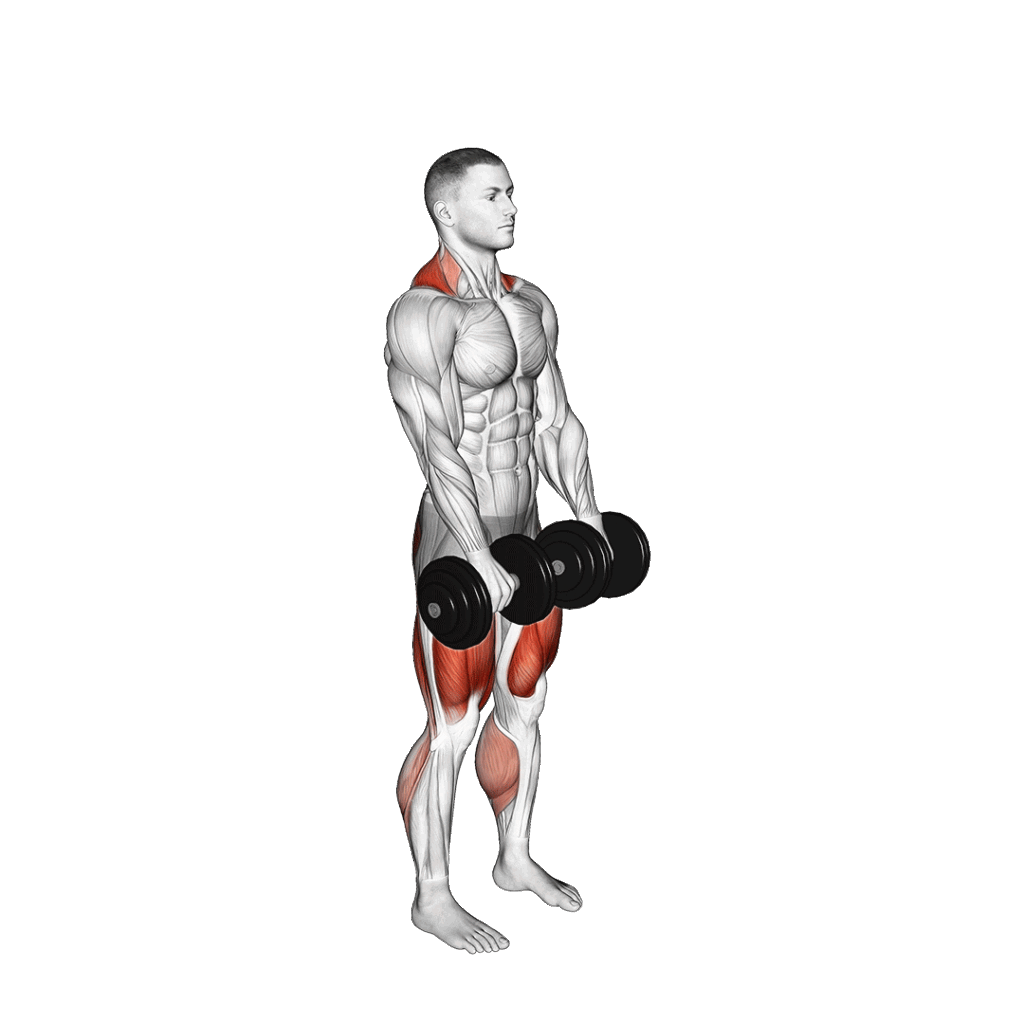
How to perform the Dumbbell RDL to Jump Shrug exercise? Start in a standing position, holding a dumbbell in each hand with your palms facing your body. Engage your core and maintain a slight bend in the knees as you hinge at the hips to perform a Romanian deadlift (RDL), lowering the dumbbells towards the floor while keeping your back straight and chest up.
Once you reach a comfortable stretch in the hamstrings, explosively extend through the hips, knees, and ankles to jump upwards while shrugging your shoulders toward your ears. Land softly with bent knees and repeat for the desired number of reps.
This exercise effectively targets the traps, engaging them during both the RDL movement and explosive jump shrug. It also recruits other muscles like glutes, hamstrings, and lower back for overall strength development.
5. Dumbbell Seated Gittleson Shrug
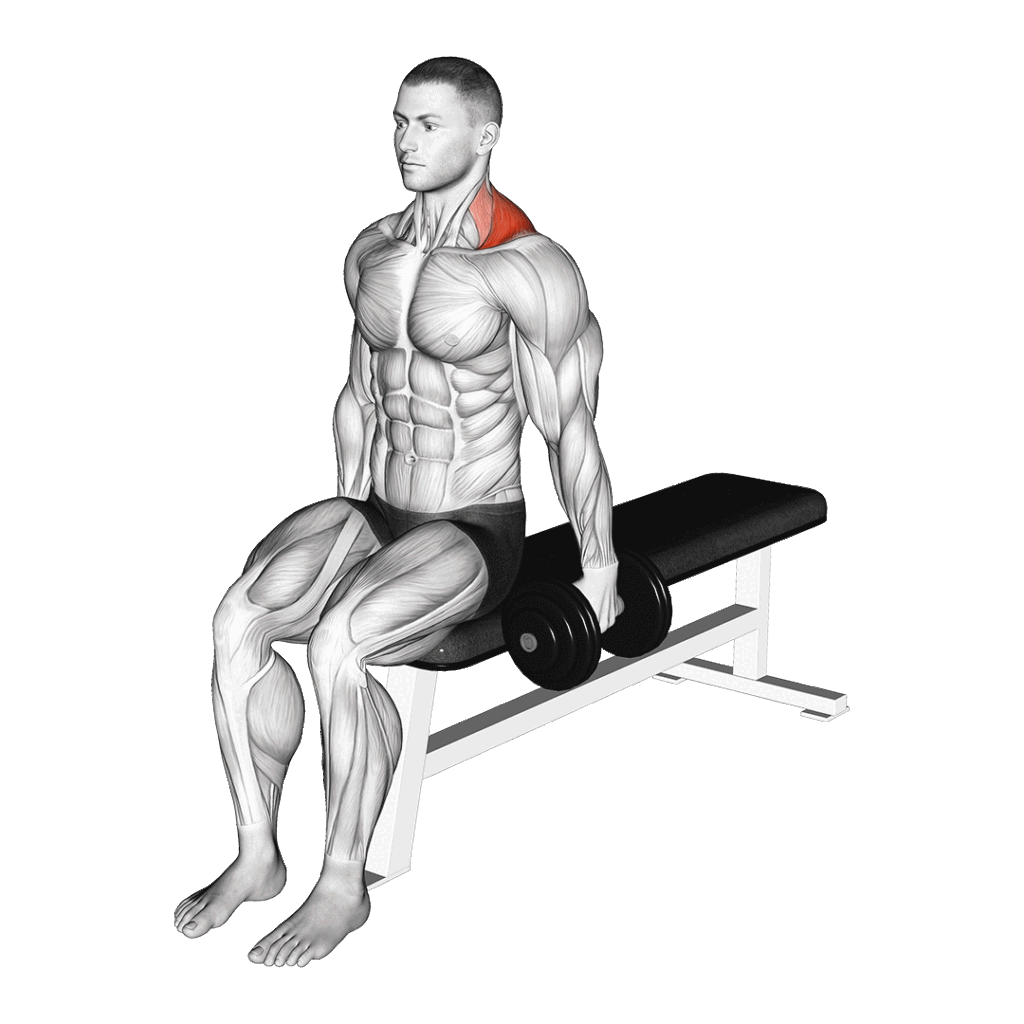
Transitioning from the explosive movement of the Dumbbell RDL to Jump Shrug, the Dumbbell Seated Gittleson Shrug is a seated variation targeting the trapezius muscles. To perform this exercise, sit on a bench with dumbbells by your sides, and then elevate your shoulders as high as possible while keeping your arms straight.
This movement specifically engages the upper traps and offers an effective way to add dimension to your upper back muscles.
When executing this exercise, it’s crucial to maintain proper posture and control throughout each repetition. It’s key to focus on elevating and retracting your shoulders rather than simply lifting weights up and down.
6. Dumbbell Decline Shrug
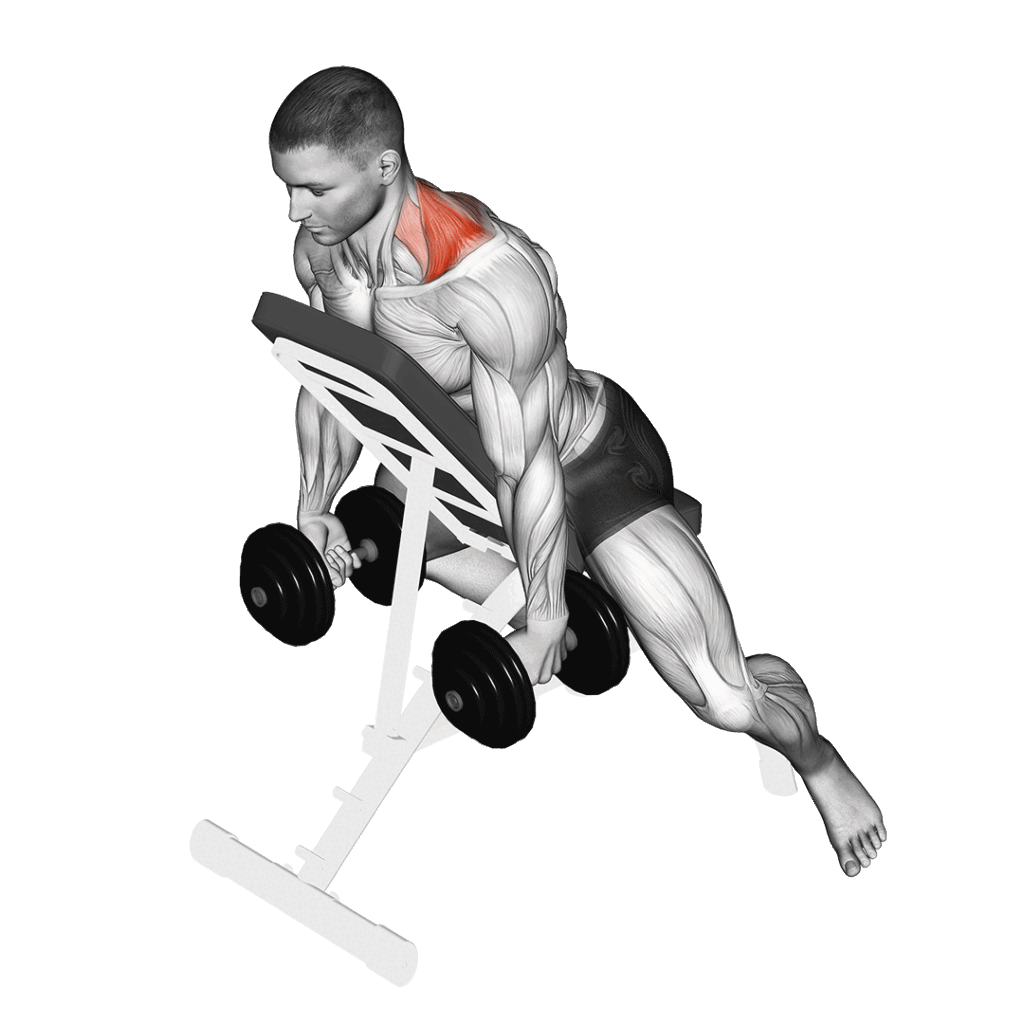
To perform the dumbbell decline shrug, lie on a decline bench with a dumbbell in each hand. Let your arms hang straight down at your sides. Keep your shoulders back and chest up throughout the exercise.
Elevate your shoulders as high as possible by contracting the trapezius muscles before slowly lowering them back down to the starting position. Aim for controlled movements and avoid using momentum to lift the weights.
Engage your traps by focusing on lifting with effort instead of speed or weight. This exercise effectively targets the lower portion of the trapezius muscle and is an excellent addition to any upper body workout routine.
7. Dumbbell Decline Shrug (Version 2)
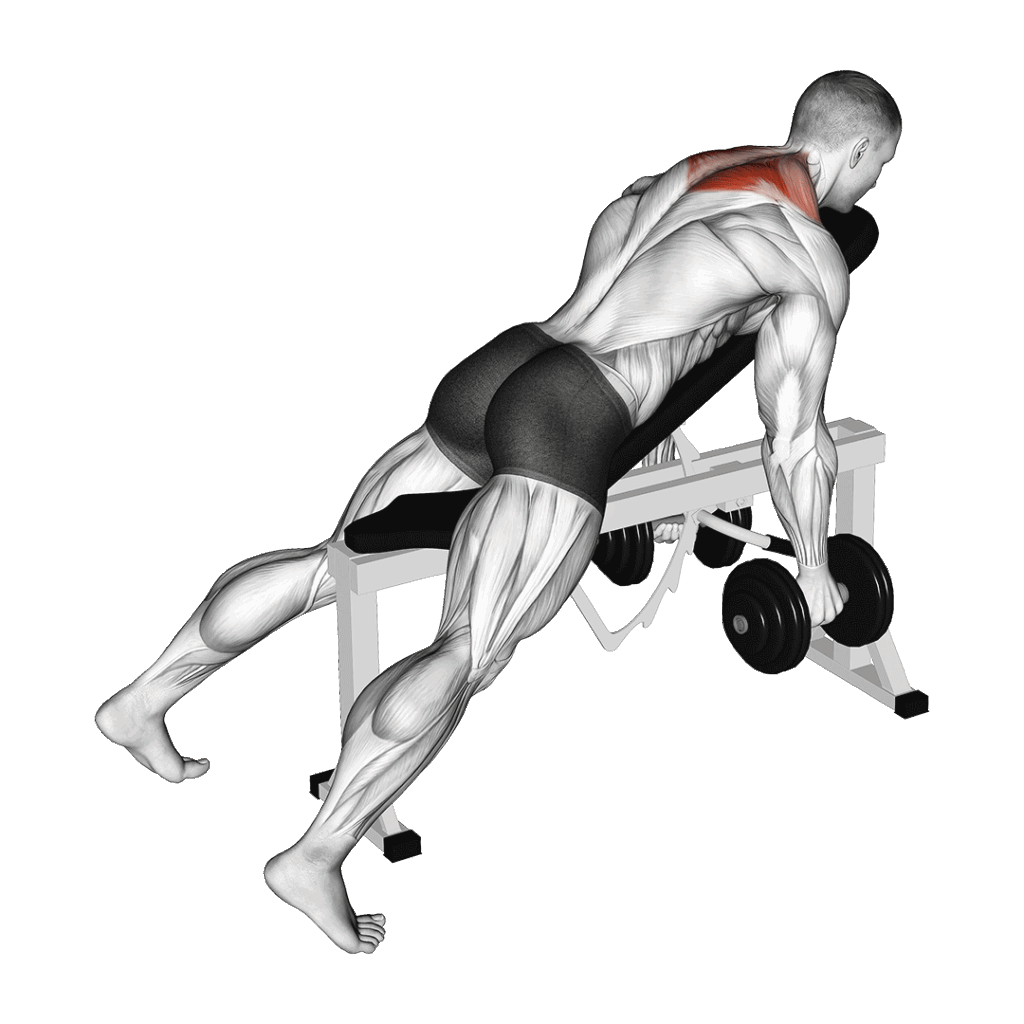
For an intensified version of the dumbbell decline shrug, grasp a pair of dumbbells and lie on a decline bench set at a 30-45 degree angle. With your arms extended toward the ground, retract your shoulder blades and lift the weights by shrugging your shoulders upward.
Hold for a moment at the top, then gradually lower the dumbbells back to the starting position.
Ensure proper control throughout this exercise to maximize muscle engagement and stability. Maintain a slow and deliberate movement pattern while focusing on squeezing your traps at the top of each repetition.
How to Properly Perform Each Exercise
Read more to make sure you’re getting the most out of your trap-building workout routine!
Common mistakes to avoid
When performing dumbbell trap exercises, it’s essential to be aware of common mistakes that can hinder your progress and potentially lead to injury. Here are some pitfalls to watch out for:
- Rounded Shoulders: Avoid hunching over during shrug movements, as this can place excessive strain on the neck and upper back.
- Overly Heavy Weights: Using weights that are too heavy can compromise your form and increase the risk of muscle imbalances or strains.
- Lack of Full Range of Motion: Ensure you’re fully engaging and releasing the traps with each repetition, avoiding short or partial movements.
- Limited Shoulder Blade Retraction: Failing to retract your shoulder blades during shrugs reduces the effectiveness of the exercise and limits trap activation.
- Neglecting Proper Breathing Technique: It’s crucial to maintain controlled breathing throughout each movement to optimize oxygen flow and support muscular engagement.
- Excessive Momentum: Avoid using momentum to lift the dumbbells, as this diminishes the targeted muscle recruitment and places strain on other areas.
- Neglecting Warm-up Sets: Skipping warm-up sets can increase the risk of injury and prevent optimal performance during your workout session.

Variations and modifications
To maximize the benefits of dumbbell trap exercises, consider incorporating variations and modifications into your routine. These adjustments not only add diversity to your workouts but also target different areas of the traps for a well-rounded development. Here are some variations and modifications you can try:
- Tempo Variation: Experiment with slow and controlled movements during your shrug exercises to increase time under tension and enhance muscle engagement.
- Grip Variations: Alter your grip width and hand positioning during dumbbell shrugs to emphasize different parts of the trapezius muscles.
- Isometric Holds: Introduce isometric holds at the top of the shrug movement to intensify muscle contraction and challenge your traps further.
- Unilateral Exercises: Incorporate single-arm shrugs or unilateral movements to address any strength imbalances between your left and right traps.
- Range of Motion Adjustments: Explore partial range-of-motion shrugs or incorporate full range-of-motion shrugs to target specific areas of the traps more effectively.
Tips for Incorporating Dumbbell Trap Exercises into Your Workout Routine
When adding dumbbell trap exercises to your workout routine, focus on a moderate frequency and rep range to see results. Emphasize proper form over heavy weights, consider pairing these exercises with complementary movements, and prioritize rest and recovery for optimal muscle growth.
Frequency and rep range
To effectively build and strengthen your traps, aim to incorporate dumbbell trap exercises into your workout routine 2-3 times per week. It’s essential to allow for proper rest and recovery between sessions to avoid overtraining.
When it comes to the rep range, strive for 8-12 repetitions per set to promote muscle hypertrophy and strength development. However, varying the rep range occasionally by incorporating lower or higher reps can also be beneficial in challenging the muscles in different ways and avoiding plateaus.
Consistent training with moderate to heavy weights within this rep range will help stimulate optimal muscle growth while ensuring that you maintain proper form throughout each exercise.

Proper form over heavy weights
Transitioning from focusing on the frequency and rep range to ensuring proper form over heavy weights is crucial for effective trap development. It’s important to prioritize maintaining correct positioning and movement throughout each exercise rather than simply lifting heavier dumbbells.
Concentrating on technique not only reduces the risk of injury but also maximizes muscle engagement, leading to optimal growth and strength gains in the upper back area.
Engaging in exercises with lighter weights while executing perfect form can yield superior results compared to struggling with heavier loads using improper technique, ultimately enhancing muscle activation and overall trap development.
Pairing with other exercises
To optimize your trap-building workout, pair these dumbbell exercises with other upper body movements like bent-over rows, lat pulldowns, or seated cable rows. Combining these exercises allows for a holistic approach to strengthening different muscle groups simultaneously.
You can also integrate some shoulder-focused workouts such as lateral raises and overhead presses to enhance overall upper body development.
Additionally, incorporating compound exercises like deadlifts and pull-ups can further engage the traps while involving multiple muscle groups for efficient training. By integrating these complementary movements into your routine, you ensure balanced muscular development and maximize the effectiveness of your trap-focused workouts.
Rest and recovery
Rest and recovery are crucial components of any workout routine. After performing dumbbell exercises for traps, it’s essential to allow the muscles time to repair and rebuild. Adequate rest can help prevent injury and improve overall muscle function.
During this time, focus on proper nutrition and hydration to support the body’s recovery process. It’s also beneficial to engage in activities that promote relaxation, such as stretching or low-impact exercises, to aid in muscle recovery.
Incorporating rest days into your training schedule is key for optimal trap muscle development. Listen to your body and adjust your workout frequency based on how well you recover from each session.
Conclusion

In conclusion, these 7 dumbbell exercises for traps offer practical and efficient ways to build stronger and fuller upper back muscles. By incorporating these strategies into your workout routine, you can enhance the impact of your strength and conditioning program.
With proper guidance on performing each exercise and tips for implementation, you are well-equipped to achieve significant improvements in trap strength. Consider exploring additional resources for further reading or consultation with fitness professionals to maximize your progress.
Take action now towards a more robust upper back by committing to consistent training and focus on correct form throughout your workouts.
FAQs
1. What are dumbbell exercises for traps?
Dumbbell exercises for traps target your upper back muscles, including your trapezius, latissimus dorsi, and rear deltoids, to build strength and a fuller appearance.
2. Can I use free weights like dumbbells to work on my traps?
Absolutely! Free weights such as dumbbells engage your trap muscles effectively through motions like shrugs and rows which enhance electromyographic activity leading to muscle growth.
3. Do these dumbbell trap exercises require other equipment?
Mostly no; you can perform these strength-enhancing workouts with just a pair of dumbbells, though having access to a pullup bar or bench can offer variety in your routine.
4. How do these upper back exercises benefit my daily activities?
These movements improve the power of your delts and biceps, providing better support for everyday actions from carrying groceries to maintaining good posture while walking or sitting.
5. Will focusing on my traps help me with other forms of exercise?
Indeed it will! Strengthening your trapezius adds stability that supports performing calisthenics, squats, push-ups effectively while protecting against potential injuries during weight training or fitness club activities.
6. Are there any famous athletes who focus on their trap development?
Yes, professional bodybuilders like Shawn Ray and powerlifters pay special attention to developing strong traps which contribute significantly towards their impressive physiques and lifting capabilities.

Author
Years ago, the spark of my life’s passion ignited in my mind the moment I stepped into the local gym for the first time. The inaugural bead of perspiration, the initial endeavor, the very first surge of endorphins, and a sense of pride that washed over me post-workout marked the beginning of my deep-seated interest in strength sports, fitness, and sports nutrition. This very curiosity blossomed rapidly into a profound fascination, propelling me to earn a Master’s degree in Physical Education from the Academy of Physical Education in Krakow, followed by a Sports Manager diploma from the Jagiellonian University. My journey of growth led me to gain more specialized qualifications, such as being a certified personal trainer with a focus on sports dietetics, a lifeguard, and an instructor for wellness and corrective gymnastics. Theoretical knowledge paired seamlessly with practical experience, reinforcing my belief that the transformation of individuals under my guidance was also a reflection of my personal growth. This belief holds true even today. Each day, I strive to push the boundaries and explore new realms. These realms gently elevate me to greater heights. The unique combination of passion for my field and the continuous quest for growth fuels my drive to break new ground.





